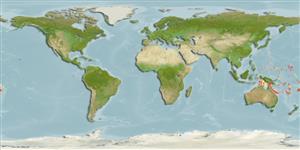Common names from other countries
>
Pleuronectiformes (Flatfishes) >
Soleidae (Soles)
Etymology: Aseraggodes: Greek, aggos, -eos, -ous = vessel, uterus, carapace of a crab + Greek, aseros, -a, -on = to remove the appetite (Ref. 45335).
Eponymy: Dr Douglas Merritt Whitaker (1904–1973) was the first Provost of Stanford University (1952–1955), having previously worked there as Professor of Biology. [...] (Ref. 128868), visit book page.
Environment: milieu / Klimaatzone / Diepte / distribution range
Ecologie
marien rifbewoner; diepte 0 - 37 m (Ref. 57560). Tropical; 35°N - 23°S, 130°E - 175°W
Pacific Ocean: Marshall Islands and Society Islands.
Grootte / Gewicht / Leeftijd
Maturiteit: Lm ? range ? - ? cm
Max length : 4.0 cm SL mannelijk / geslacht onbekend; (Ref. 1602)
Korte beschrijving
Determinatiesleutels | Morfologie | Morfometrie
Dorsale zachte stralen (totaal) : 71 - 78; Anale zachte stralen: 48 - 53; Wervels: 36 - 38. Diagnosis. Dorsal rays 71-78; anal rays 48-53; pelvic rays 5 (3 in one side on one aberrant specimen); caudal rays 18, 14 branched (17 rays, 13 branched in one specimen). Lateral-line scales 77-86, including 10-12 anterior to a vertical at upper end of gill opening). Most scales of ocular side of body with 8-10 cteni (up to 11 on largest specimens); narrowest interorbital space with 2 scales; eyes with only I or 2 scales extending onto medial edge, and only about 3 rows anteriorly. Vertebrae 36-38; dorsal pterygiophores anterior to fourth neural spine 14-15. Body depth 2.55-2.75 in SL; head length (HL) 4.1-4.35 in SL. An overhanging fleshy snout, the lower edge of upper lip usually extending ventral to lower lip and jutting anterior to profile of head below mouth (more evident in smaller specimens); eye diameter 4.7-5.55 in HL; upper eye varying from one-half to full eye diameter anterior to lower eye; interorbital space very narrow, the vertical distance separating eyes less than half eye diameter. Caudal peduncle present, its length 7.2-10.0 in HL. Ventral edge of head posterior to mouth with 10-19 lappet-like cirri; edge of operculum at gill opening with slender well-spaced cirri on both sides; edge of lengthwise membranous ridges of dorsal and anal rays of ocular side with cirri, reduced and disappearing on about posterior half of fins; cirri also present on rays of blind side, but fewer and restricted to more anterior rays. Lateral line aligned with dorsal edge of upper eye; upper end of gill opening in line with ventral fleshy edge of lower eye; anterior nostril reaching fleshy base of lower eye when laid back. Caudal fin slightly pointed, its length 3.05-3.65 in SL; longest dorsal ray 1.4-1.8 in HL; anal rays and all but anterior dorsal rays of larger specimens branched distally; pelvic fins long 1.65-1.85 in HL, the tip of longest ray extending to base of third or fourth anal ray. Color in alcohol of ocular side of most specimens pale tan without any dark markings; American Samoan specimens with faint dark blotches in 3 rows on the ocular side, one row below base of dorsal fin, one along lateral line and one above base of anal fin; yellowish tan with many irregular pale markings partially outlined with dusky brown; fins pale with dusky specks (Ref. 57560).
Body shape (shape guide): short and / or deep.
A single specimen collected from a lagoon coral head at Rongerik Atoll, at a depth of 6 m (Ref. 1602).
Levenscyclus en paargedrag
Maturiteit | Voortplanting | Paaien | Eieren | Fecunditeit | Larven
Myers, R.F., 1991. Micronesian reef fishes. Second Ed. Coral Graphics, Barrigada, Guam. 298 p. (Ref. 1602)
Status op de Rode Lijst van het IUCN (Ref. 130435: Version 2025-1)
Gevaar voor de mens
Harmless
Gebruik door de mens
Tools
Speciale rapporten
Download XML
Internetbronnen
Estimates based on models
Preferred temperature (Ref.
123201): 25 - 29.4, mean 28.2 °C (based on 852 cells).
Fylogenetische diversiteitsindex (Ref.
82804): PD
50 = 0.5000 [Uniqueness, from 0.5 = low to 2.0 = high].
Bayesian length-weight: a=0.00977 (0.00466 - 0.02049), b=3.07 (2.90 - 3.24), in cm total length, based on LWR estimates for this (Sub)family-body shape (Ref.
93245).
Trofisch niveau (Ref.
69278): 3.3 ±0.5 se; based on size and trophs of closest relatives
Weerstandsvermogen (Ref.
120179): Hoog, minimale populatieverdubbelingstijd minder dan 15 maanden (Preliminary K or Fecundity.).
Fishing Vulnerability (Ref.
59153): Low vulnerability (10 of 100).
🛈
